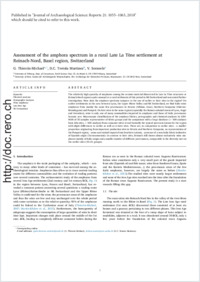Assessment of the amphora spectrum in a rural Late La Tène settlement at Reinach-Nord, Basel region, Switzerland
DOKPE
- Thierrin‐Michael, Gisela University of Fribourg, Earth Science Unit, Fribourg, Switzerland
- Martinez, D. C. Tretola Institut für Archäologische Wissenschaften, University of Bern, Switzerland
- Serneels, Vincent University of Fribourg, Earth Science Unit, Fribourg, Switzerland
-
01.10.2018
Published in:
- Journal of Archaeological Science: Reports. - 2018, vol. 21, p. 1055–1063
English
The relatively high quantity of amphorae among the ceramic material discovered in Late La Tène structures at Reinach-Nord appears quite unusual at a rural settlement of this period in NE Switzerland and warranted further investigation. How does the amphora spectrum compare to the one of earlier or later sites in the region? On earlier settlements in the area between Lyon, the Upper Rhine Valley and NE Switzerland, we find Italic wine amphorae from mainly the same few provenances in Etruria (Albinia, Cosa), Northern Campania (Falerne/Mondragone) and Pompeii. On later sites in the same region (especially the Roman colonial towns of Lyon, Augst and Avenches), wine is only one of many commodities imported in amphorae and those of Italic provenance become rare. Macroscopic classification of the amphora fabrics, petrographic and chemical analyses by XRF-WDS of 35 samples representative of fabric groups and the comparison with a large database (> 500 analyses from kiln sites, > 500 analyses from consumer sites) reveal basically the typical spectrum known for the region with slight differences to earlier as well as to later sites. These are, in comparison to earlier sites: - a smaller proportion originating from important production sites in Etruria and Northern Campania, no representation of the Pompeii region; - some ascertained imports from Southern Latium; - presence of a non-Italic fabric indicative of Spanish origin (Tarraconnensis). In contrast to later sites, Reinach still shows almost exclusively wine amphorae mainly of Italic origin and a smaller number of different provenances, comparable to the diversity met on the earlier sites (10–15 groups).
- Faculty
- Faculté des sciences et de médecine
- Department
- Département de Géosciences
- Language
-
- English
- Classification
- Archeology
- License
-
License undefined
- Identifiers
-
- RERO DOC 323832
- DOI 10.1016/j.jasrep.2017.11.039
- Persistent URL
- https://folia.unifr.ch/unifr/documents/307210
Statistics
Document views: 153
File downloads:
- pdf: 259
